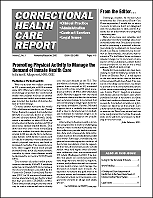Self-Monitoring Blood Glucose in the Correctional Setting
Author: Richard M. Garden, M.D., M.P.H..; Nancy Howard, R.N..; Michelle Buswell, R.N..
Source: Volume 09, Number 05, July/August 2008 , pp.65-68(4)

next article > |return to table of contents
Abstract:
By maintaining tight control of their serum glucose levels, patients can lessen or avoid the morbidity and mortality associated with diabetes. Recent studies indicate nearly two thirds of diabetics are above their goals for glycosylated hemoglobin (HgbA1c) (American Association of Clinical Endocrinologists). It may be even more difficult for patients to achieve euglycemia, or normal glucose levels, while incarcerated.Prison life restricts inmates’ access to proper diet, exercise, and insulin, and it can limit their ability to monitor their blood glucose levels. This ongoing monitoring allows the diabetic inmate to make real-time adjustments in lifestyle.Without knowing blood sugar levels, one cannot act to improve on them.Keywords: insulin-dependent, glucometer, Glycohemoglobin, Hawthorn Effect, blood sugar
Affiliations:
1: Utah Department of Corrections; 2: Utah Department of Corrections; 3: Utah Department of Corrections.